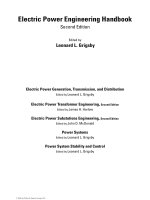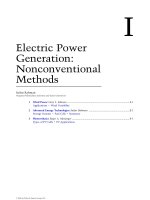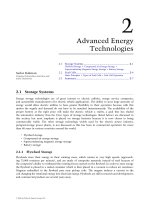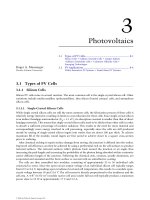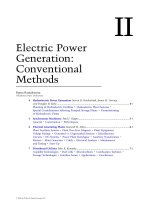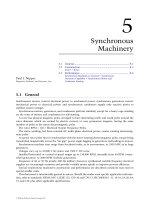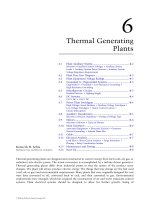power system stability and control chuong (4)
Bạn đang xem bản rút gọn của tài liệu. Xem và tải ngay bản đầy đủ của tài liệu tại đây (73.4 KB, 8 trang )
2
Advanced Energy
Technologies
Saifur Rahman
Virginia Polytechnic Institute and
State University
2.1 Storage Systems 2-1
Flywheel Storage
.
Compressed Air Energy Storage
.
Superconducting Magnetic Energy Storage
.
Battery Storage
2.2 Fuel Cells 2-4
Basic Principles
.
Types of Fuel Cells
.
Fuel Cell Operation
2.3 Summary 2-7
2.1 Storage Systems
Energy storage technologies are of great interest to electric utilities, energy service companies,
and automobile manufacturers (for electric vehicle application). The ability to store large amounts of
energy would allow electric utilities to have greater flexibility in their operation because with this
option the supply and demand do not have to be matched instantaneously. The availability of the
proper battery at the right price will make the electric vehicle a reality, a goal that has eluded
the automotive industry thus far. Four types of storage technologies (listed below) are discussed in
this section, but most emphasis is placed on storage batteries because it is now closest to being
commercially viable. The other storage technology widely used by the electric power industry,
pumped-storage power plants, is not discussed as this has been in commercial operation for more
than 60 years in various countries around the world.
.
Flywheel storage
.
Compressed air energy storage
.
Superconducting magnetic energy storage
.
Battery storage
2.1.1 Flywheel Storage
Flywheels store their energy in their rotating mass, which rotates at very high speeds (approach-
ing 75,000 rotations per minute), and are made of composite materials instead of steel because of
the composite’s ability to withstand the rotating forces exerted on the flywheel. In order to store energy
the flywheel is placed in a sealed container which is then placed in a vacuum to reduce air resistance.
Magnets embedded in the flywheel pass near pickup coils. The magnet induces a current in the
coil changing the rotational energy into electrical energy. Flywheels are still in research and development,
and commercial products are several years away.
ß 2006 by Taylor & Francis Group, LLC.
2.1.2 Compressed Air Energy Storage
As the name implies, the compressed air energy storage (CAES) plant uses electricity to compress air
which is stored in underground reservoirs. When electricity is needed, this compressed air is w ithdrawn,
heated with gas or oil, and run through an expansion turbine to drive a generator. The compressed air
can be stored in several types of underground structures, including caverns in salt or rock formations,
aquifers, and depleted natural gas fields. Typically the compressed air in a CAES plant uses about one
third of the premium fuel needed to produce the same amount of electricity as in a conventional plant.
A 290-MW CAES plant has been in operation in Germany since the early 1980s with 90% availability
and 99% starting reliability. In the U.S., the Alabama Electric Cooperative runs a CAES plant that stores
compressed air in a 19-million cubic foot cavern mined from a salt dome. This 110-MW plant has a
storage capacity of 26 h. The fixed-price turnkey cost for this first-of-a-kind plant is about $400=kW in
constant 1988 dollars.
The turbomachinery of the CAES plant is like a combustion turbine, but the compressor and the
expander operate independently. In a combustion turbine, the air that is used to drive the turbine is
compressed just prior to combustion and expansion and, as a result, the compressor and the expander
must operate at the same time and must have the same air mass flow rate. In the case of a CAES plant,
the compressor and the expander can be sized independently to provide the utility-selected ‘‘optimal’’
MW charge and discharge rate which determines the ratio of hours of compression required for each
hour of turbine-generator operation. The MW ratings and time ratio are influenced by the utility’s
load curve, and the price of off-peak power. For example, the CAES plant in Germany requires 4 h
of compression per hour of generation. On the other hand, the Alabama plant requires 1.7 h of
compression for each hour of generation. At 110-MW net output, the power ratio is 0.818 kW output
for each kilowatt input. The heat rate (LHV) is 4122 BTU=kWh with natural gas fuel and 4089
BTU=kWh with fuel oil. Due to the storage option, a partial-load operation of the CAES plant is also
very flexible. For example, the heat rate of the expander increases only by 5%, and the airflow decreases
nearly linearly when the plant output is turned down to 45% of full load. However, CAES plants have
not reached commercial viability beyond some prototypes.
2.1.3 Superconducting Magnetic Energy Storage
A third type of advanced energy storage technology is superconducting magnetic energy storage (SMES),
which may someday allow electric utilities to store electricity with unparalled efficiency (90% or more).
A simple description of SMES operation follows.
The electricity storage medium is a doughnut-shaped electromagnetic coil of superconducting wire.
This coil could be about 1000 m in diameter, installed in a trench, and kept at superconducting
temperature by a refrigeration system. Off-peak electricity, converted to direct current (DC), would be
fed into this coil and stored for retrieval at any moment. The coil would be kept at a low-temperature
superconducting state using liquid helium. The time between charging and discharging could be as little
as 20 ms with a round-trip AC–AC efficiency of over 90%.
Developing a commercial-scale SMES plant presents both economic and technical challenges. Due to
the high cost of liquiud helium, only plants with 1000-MW, 5-h capacity are economically attractive.
Even then the plant capital cost can exceed several thousand dollars per kilowatt. As ceramic supercon-
ductors, which become superconducting at higher temperatures (maintained by less expensive liquid
nitrogen), become more widely available, it may be possible to develop smaller scale SMES plants at a
lower price.
2.1.4 Battery Storage
Even though battery storage is the oldest and most familiar energy storage device, significant advances
have been made in this technology in recent years to deserve more attention. There has been renewed
interest in this technology due to its potential application in non-polluting electric vehicles. Battery
ß 2006 by Taylor & Francis Group, LLC.
systems are quiet and non-polluting, and can be installed near load centers and existing suburban
substations. These have round-trip AC–AC efficiencies in the range of 85%, and can respond to load
changes within 20 ms. Several U.S., European, and Japanese utilities have demonstrated the application
of lead–acid batteries for load-following applications. Some of them have been as large as 10 MW with
4 h of storage.
The other player in battery development is the automotive industry for electric vehicle application. In
1991, General Motors, Ford, Chrysler, Electric Power Research Institute (EPRI), several utilities, and
the U.S. Department of Energy (DOE) formed the U.S. Advanced Battery Consortium (USABC)
to develop better batteries for electric vehicle (EV) applications. A brief introduction to some of
the available battery technologies as well some that are under study is presented in the following
(Source: http:== www.eren.doe.gov=consumerinfo=refbriefs=fa1=html).
2.1.4.1 Battery Types
Chemical batteries are individual cells filled with a conducting medium-electrolyte that, when connected
together, form a battery. Multiple batteries connected together form a battery bank. At present, there are
two main types of batteries: primary batteries (non-rechargeable) and secondary batteries (recharge-
able). Secondary batteries are further divided into two categories based on the operating temperature of
the electrolyte. Ambient operating temperature batteries have either aqueous (flooded) or nonaqueous
electrolytes. High operating temperature batteries (molten electrodes) have either solid or molten
electrolytes. Batteries in EVs are the secondary-rechargeable-type and are in either of the two sub-
categories. A battery for an EV must meet certain performance goals. These goals include quick
discharge and recharge capability, long cycle life (the number of discharges before becoming unservice-
able), low cost, recyclability, high specific energy (amount of usable energy, measured in watt-hours per
pound [lb] or kilogram [kg]), high energy density (amount of energy stored per unit volume), specific
power (determines the potential for acceleration), and the ability to work in extreme heat or cold. No
battery currently available meets all these criteria.
2.1.4.2 Lead–Acid Batteries
Lead–acid starting batteries (shallow-cycle lead–acid secondary batteries) are the most common battery
used in vehicles today. This battery is an ambient temperature, aqueous electrolyte battery. A cousin to
this battery is the deep-cycle lead–acid battery, now wi dely used in golf carts and forklifts. The first
electric cars built also used this technology. Although the lead–acid battery is relatively inexpensive, it is
very heavy, with a limited usable energy by weight (specific energy). The battery’s low specific energy and
poor energy density make for a very large and heavy battery pack, which cannot power a vehicle as far as
an equivalent gas-powered vehicle. Lead–acid batteries should not be discharged by more than 80% of
their rated capacity or depth of discharge (DOD). Exceeding the 80% DOD shortens the life of the
battery. Lead–acid batteries are inexpensive, readily available, and are highly recyclable, using the
elaborate recycling system already in place. Research continues to try to improve these batteries.
A lead–acid nonaqueous (gelled lead acid) battery uses an electrolyte paste instead of a liquid. These
batteries do not have to be mounted in an upright position. There is no electrolyte to spill in an accident.
Nonaqueous lead–acid batteries typically do not have as high a life cycle and are more expensive than
flooded deep-cycle lead–acid batteries.
2.1.4.3 Nickel Iron and Nickel Cadmium Batteries
Nickel iron (Edison cells) and nickel cadmium (nicad) pocket and sintered plate batteries have been in
use for many years. Both of these batteries have a specific energy of around 25 Wh=lb (55 Wh=kg), which
is higher than advanced lead–acid batteries. These batteries also have a long cycle life. Both of these
batteries are recyclable. Nickel iron batteries are non-toxic, while nicads are toxic. They can also be
discharged to 100% DOD without damage. The biggest drawback to these batteries is their cost.
Depending on the size of battery bank in the vehicle, it may cost between $20,000 and $60,000 for the
batteries. The batteries should last at least 100,000 mi (160,900 km) in normal service.
ß 2006 by Taylor & Francis Group, LLC.
2.1.4.4 Nickel Metal Hydride Batteries
Nickel metal hydride batteries are offered as the best of the next generation of batteries. They have a high
specific energy: around 40.8 Wh=lb (90 Wh=kg). According to a U.S. DOE report, the batteries are
benign to the environment and are recyclable. They also are reported to have a very long cycle life. Nickel
metal hydride batteries have a high self-discharge rate: they lose their charge when stored for long
periods of time. They are already commercially available as ‘‘AA’’ and ‘‘C’’ cell batteries, for small
consumer appliances and toys. Manufacturing of larger batteries for EV applications is only available
to EV manufacturers. Honda is using these batteries in the EV Plus, which is available for lease in
California.
2.1.4.5 Sodium Sulfur Batteries
This battery is a high-temperature battery, w ith the electrolyte operating at temperatures of 5728F
(3008C). The sodium component of this battery explodes on contact with water, which raises certain
safety concerns. The materials of the battery must be capable of withstanding the high internal
temperatures they create, as well as freezing and thawing cycles. This battery has a very high specific
energy: 50 Wh=lb (110 Wh=kg). The Ford Motor Company uses sodium sulfur batteries in their Ecostar,
a converted delivery minivan that is currently sold in Europe. Sodium sulfur batteries are only available
to EV manufacturers.
2.1.4.6 Lithium Iron and Lithium Polymer Batteries
The USABC considers lithium iron batteries to be the long-term battery solution for EVs. The batteries
have a very high specific energy: 68 Wh=lb (150 Wh=kg). They have a molten-salt electrolyte and share
many features of a sealed bipolar battery. Lithium iron batteries are also reported to have a very long
cycle life. These are widely used in laptop computers. These batteries will allow a vehicle to travel
distances and accelerate at a rate comparable to conventional gasoline-powered vehicles. Lithium
polymer batteries eliminate liquid electrolytes. They are thin and flexible, and can be molded into a
variety of shapes and sizes. Neither type will be ready for EV commercial applications until early in the
21st century.
2.1.4.7 Zinc and Aluminum Air Batteries
Zinc air batteries are currently being tested in postal trucks in Germany. These batteries use either
aluminum or zinc as a sacrificial anode. As the battery produces electricity, the anode dissolves into the
electrolyte. When the anode is completely dissolved, a new anode is placed in the vehicle. The aluminum
or zinc and the electrolyte are removed and sent to a recycling facility. These batteries have a specific
energy of over 97 Wh=lb (200 Wh=kg). The German postal vans currently carry 80 kWh of energy in
their battery, giving them about the same range as 13 gallons (49.2 liters) of gasoline. In their tests, the
vans have achieved a range of 615 mi (990 km) at 25 miles per hour (40 km =h).
2.2 Fuel Cells
In 1839, a British Jurist and an amateur physicist named William Grove first discovered the principle of
the fuel cell. Grove utilized four large cells, each containing hydrogen and oxygen, to produce electricity
and water which was then used to split water in a different container to produce hydrogen and oxygen.
However, it took another 120 years until NASA demonstrated its use to provide electricity and water for
some early space flights. Today the fuel cell is the primary source of electricity on the space shuttle. As a
result of these successes, industry slowly began to appreciate the commercial value of fuel cells. In
addition to stationary power generation applications, there is now a strong push to develop fuel cells for
automotive use. Even though fuel cells provide high performance characterisitics, reliability, durability,
and environmental benefits, a very high investment cost is still the major barrier against large-scale
deployments.
ß 2006 by Taylor & Francis Group, LLC.
2.2.1 Basic Principles
The fuel cell works by processing a hydrogen-rich fuel—usually natural gas or methanol—into
hydrogen, which, when combined with oxygen, produces electricity and water. This is the reverse
electrolysis process. Rather than burning the fuel, however, the fuel cell converts the fuel to electricity
using a highly efficient electrochemical process. A fuel cell has few moving parts, and produces very little
waste heat or gas.
A fuel cell power plant is basically made up of three subsystems or sections. In the fuel-processing
section, the natural gas or other hydrocarbon fuel is converted to a hydrogen-rich fuel. This is normally
accomplished through what is called a steam catalytic reforming process. The fuel is then fed to the
power section, where it reacts with oxygen from the air in a large number of individual fuel cells to
produce direct current (DC) electricity, and by-product heat in the form of usable steam or hot water.
For a power plant, the number of fuel cells can vary from several hundred (for a 40-kW plant) to several
thousand (for a multi-megawatt plant). In the final, or third stage, the DC electricity is converted in the
power conditioning subsystem to electric utility-grade alternating current (AC).
In the power section of the fuel cell, which contains the electrodes and the electrolyte, two separate
electrochemical reactions take place: an oxidation half-reaction occurring at the anode and a reduction
half-reaction occurring at the cathode. The anode and the cathode are separated from each other by the
electrolyte. In the oxidation half-reaction at the anode, gaseous hydrogen produces hydrogen ions, which
travel through the ionically conducting membrane to the cathode. At the same time, electrons travel
through an external circuit to the cathode. In the reduction half-reaction at the cathode, oxygen supplied
from air combines with the hydrogen ions and electrons to form water and excess heat. Thus, the final
products of the overall reaction are electricity, water, and excess heat.
2.2.2 Types of Fuel Cells
The electrolyte defines the key properties, particularly the operating temperature, of the fuel cell.
Consequently, fuel cells are classified based on the types of electrolyte used as described below.
1. Polymer Electrolyte Membrane (PEM)
2. Alkaline Fuel Cell (AFC)
3. Phosphoric Acid Fuel Cell (PAFC)
4. Molten Carbonate Fuel Cell (MCFC)
5. Solid Oxide Fuel Cell (SOFC)
These fuel cells operate at different temperatures and each is best suited to particular applications.
The main features of the five types of fuel cells are summarized in Table 2.1.
2.2.3 Fuel Cell Operation
Basic operational characteristics of the four most common types of fuel cells are discussed in the
following.
2.2.3.1 Polymer Electrolyte Membrane (PEM)
The PEM cell is one in a family of fuel cells that are in various stages of development. It is being
considered as an alternative power source for automotive application for electric vehicles. The electrolyte
in a PEM cell is a type of polymer and is usually referred to as a membrane, hence the name. Polymer
electrolyte membranes are somewhat unusual electrolytes in that, in the presence of water, which the
membrane readily absorbs, the negative ions are rigidly held within their structure. Only the positive (H)
ions contained within the membrane are mobile and are free to carry positive charges through the
membrane in one direction only, from anode to cathode. At the same time, the organic nature of
the polymer electrolyte membrane structure makes it an electron insulator, forcing it to travel through
the outside circuit providing electric power to the load. Each of the two electrodes consists of porous
ß 2006 by Taylor & Francis Group, LLC.
carbon to which very small platinum (Pt) particles are bonded. The electrodes are somewhat porous so
that the gases can diffuse through them to reach the catalyst. Moreover, as both platinum and carbon
conduct electrons well, they are able to move freely through the electrodes. Chemical reactions that take
place inside a PEM fuel cell are presented in the following.
Anode
2H
2
! 4H
þ
þ 4e
À
Cathode
O
2
þ 4H
þ
þ 4e
À
! 2H
2
O
Net reaction: 2H
2
þ O
2
¼ 2H
2
O
Hydrogen gas diffuses through the polymer electrolyte until it encounters a Pt particle in the anode.
The Pt catalyzes the dissociation of the hydrogen molecule into two hydrogen atoms (H) bonded to two
neighboring Pt atoms. Only then can each H atom release an electron to form a hydrogen ion (H
þ
)
which travels to the cathode through the electrolyte. At the same time, the free electron travels from the
anode to the cathode through the outer circuit. At the cathode the oxygen molecule interacts with the
hydrogen ion and the electron from the outside circuit to form water. The performance of the PEM fuel
cell is limited primarily by the slow rate of the oxygen reduction half-reaction at the cathode, which is
100 times slower than the hydrogen oxidation half-reaction at the anode.
2.2.3.2 Phosphoric Acid Fuel Cell (PAFC)
Phosphoric acid technology has moved from the laboratory research and development to the first stages
of commercial application. Turnkey 200-kW plants are now available and have been installed at more
than 70 sites in the U.S., Japan, and Europe. Operating at about 2008C, the PAFC plant also produces
heat for domestic hot water and space heating, and its electrical efficiency approaches 40%. The
principal obstacle against widespread commercial acceptance is cost. Capital costs of about $2500 to
TABLE 2.1 Comparison of Five Fuel Cell Technologies
Type Electrolyte
Operating
Temperature (8C) Applications Advantages
Polymer Electrolyte
Membrane (PEM)
Solid organic polymer
poly-perflouro-sulfonic
acid
60–100 Electric utility,
transportation,
portable power
Solid electrolyte
reduces corrosion,
low temperature,
quick start-up
Alkaline (AFC) Aqueous solution of
potassium hydroxide
soaked in a matrix
90–100 Military, space Cathode reaction
faster in alkaline
electrolyte; therefore
high performance
Phosphoric Acid
(PAFC)
Liquid phosphoric acid
soaked in a matrix
175–200 Electric utility,
transportation,
and heat
Up to 85% efficiency
in co-generation
of electricity
Molten Carbonate
(MCFC)
Liquid solution of lithium,
sodium, and=or
potassium carbonates
soaked
in a matrix
600–1000 Electric utility Higher efficiency,
fuel flexibility,
inexpensive catalysts
Solid Oxide (SOFC) Solid zirconium oxide to
which a small
amount of yttria is added
600–1000 Electric utility Higher efficiency,
fuel flexibility,
inexpensive catalysts.
Solid electrolyte
advantages like PEM
ß 2006 by Taylor & Francis Group, LLC.
$4000=kW must be reduced to $1000 to $1500=kW if the technology is to be accepted in the electric
power markets.
The chemical reactions occurring at two electrodes are written as follows:
At anode: 2H
2
! 4H
þ
þ 4e
À
At cathode: O
2
þ 4H
þ
þ 4e
À
! 2H
2
O
2.2.3.3 Molten Carbonate Fuel Cell (MCFC)
Molten carbonate technology is attractive because it offers several potential advantages over PAFC.
Carbon monoxide, which poisons the PAFC, is indirectly used as a fuel in the MCFC. The higher
operating temperature of approximately 6508C makes the MCFC a better candidate for combined cycle
applications whereby the fuel cell exhaust can be used as input to the intake of a gas turbine or the boiler
of a steam turbine. The total thermal efficiency can approach 85%. This technology is at the stage of
prototype commercial demonstrations and is estimated to enter the commercial market by 2003 using
natural gas, and by 2010 with gas made from coal. Capital costs are expected to be lower than PAFC.
MCFCs are now being tested in full-scale demonstration plants. The following equations illustrate the
chemical reactions that take place inside the cell.
At anode: 2H
2
þ 2CO
2À
3
! 2H
2
O þ 2CO
2
þ 4e
À
and 2CO þ 2CO
2À
3
! 4CO
2
þ 4e
À
At cathode: O
2
þ 2CO
2
þ 4e
À
! 2O
2À
3
2.2.3.4 Solid Oxide Fuel Cell (SOFC)
A solid oxide fuel cell is currently being demonstrated at a 100-kW plant. Solid oxide technology
requires very significant changes in the structure of the cell. As the name implies, the SOFC uses a solid
electrolyte, a ceramic material, so the electrolyte does not need to be replenished during the operational
life of the cell. This simplifies design, operation, and maintenance, as well as having the potential to
reduce costs. This offers the stability and reliability of all solid-state construction and allows higher
temperature operation. The ceramic make-up of the cell lends itself to cost-effective fabrication
techniques. The tolerance to impure fuel streams make SOFC systems especially attractive for utilizing
H
2
and CO from natural gas steam-reforming and coal gasification plants. The chemical reactions inside
the cell may be written as follows:
At anode: 2H
2
þ 2O
2À
! 2H
2
O þ 4e
À
and 2CO þ 2O
2À
! 2CO
2
þ 4e
À
At cathode: O
2
þ 4e
À
! 2O
2À
2.3 Summary
Fuel cells can convert a remarkably high proportion of the chemical energy in a fuel to electricity. With
the efficiencies approaching 60%, even without co-generation, fuel cell power plants are nearly twice as
efficient as conventional power plants. Unlike large steam plants, the efficiency is not a function of the
plant size for fuel cell power plants. Small-scale fuel cell plants are just as efficient as the large ones,
whether they operate at full load or not. Fuel cells contribute significantly to the cleaner environment;
they produce dramtically fewer emissions, and their by-products are primarily hot water and carbon
dioxide in small amounts. Because of their modular nature, fuel cells can be placed at or near load
centers, resulting in savings of transmission network expansion.
ß 2006 by Taylor & Francis Group, LLC.
ß 2006 by Taylor & Francis Group, LLC.



